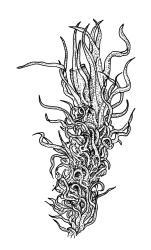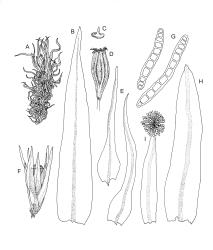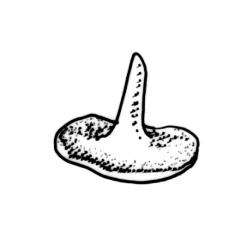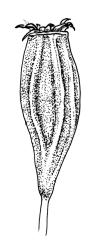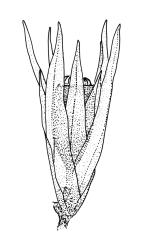- ≡ Bryodixonia perichaetialis Sainsbury, Trans. & Proc. Roy. Soc. New Zealand 75: 177 (1945)
Plants yellow-green above, becoming brown below, tufted or forming large cushions. Stems branched by innovation, to c. 30 mm, often ± denuded below. Leaves erect-spreading when moist, strongly contorted when dry, narrowly lanceolate from an ovate and pigmented base, narrowly acuminate, constricted and reflexed at mid leaf margins, entire or ± crenulate, 2–3 mm × 0.4–0.5 mm (under cover slip); upper laminal cells rounded, ± isodiametric, short-elliptic, usually some oblate, mostly 7–10 µm in greater diam., unistratose, mammillose (apparently on both surfaces); basal interior cells linear-rhomboidal, smooth, yellow to orange, radiating very weakly from the costa; cells of basal margins pale, forming a border mostly 6–8 cells wide, but merging ± gradually with the interior cells, extending nearly to the top of the base in most leaves. Costa ending shortly below the leaf apex.
Gonioautoicous. Perichaetial leaves strongly differentiated, erect when moist and dry, lanceolate, mostly with 1 elongate pleat on each side of the costa, c. 4.5 mm. Perigonia gemmiform, at base of perichaetium. Setae c. 0.2 mm; capsules ± sessile, deeply immersed, broadly obovoid, strongly 8‑ribbed when dry, c. 2 mm; exothecial cells and stomata as per genus; operculum rostrate from a convex base, 0.4–0.6 mm long. Peristome single; exostome teeth paired, broadly triangular, pale, with a median zig-zag line clearly visible on both surfaces, inserted at the capsule mouth, papillose-striolate, strongly reflexed when dry; endostome absent. Calyptra campanulate, laciniate at base, moderately hairy, enclosing only the operculum and mouth of the developing capsule. Spores unicellular, green, spherical, thick-walled, mostly 42–48 µm, finely baculate-papillose.
Sainsbury 1955, pl. 36, fig. 1.
Ulota perichaetialis is the most easily recognised species of the genus in our flora. Goffinet & Vitt (1998) noted that this species is readily distinguished from its congeners by having highly differentiated perichaetial leaves, a diminutive calyptra, and an immersed capsule.
NI: Taranaki (Mt Taranaki – several locations); SI: Nelson (Scarlett Range, Mt Zetland, Allen Range, Paparoa Range), Canterbury (summit of Arthur’s Pass, Bridal Veil Track, Hawdon River), Westland (Pegleg Creek, Kelly Range), Southland (Percy Saddle).
Endemic.
On twigs and small branches of Lophozonia menziesii and sometimes abundant on branches of Hoheria glabrata. In the mountain ranges of Nelson it often occurs at the margins of isolated copses of Lophozonia menziesii near the tree line. Also occurring on Carmichaelia sp., Coprosma spp. (including C. rugosa), and Dracophyllum longifolium. Frequently associated cryptogams include Calyptopogon mnioides, Leptostomum inclinans, Orthotrichum graphiomitrium, Ulota lutea, and Menegazzia nothofagi. On the South I. ranging from c. 840 to 1230 m (at Scarlett Range, Nelson L.D.) but apparently to c. 1325 m on the North I. (at Mt Taranaki, where it is known from several localities).
In at least some herbarium material (e.g., A.J. Fife 7409, Pegleg Creek, CHR 406532) the conic base of the operculum becomes inverted (convex) when dry and thus gives a confusing impression of the operculum form. The operculum in most, probably all, populations is rostrate from a convex base. The distortion of the dried opercula in herbarium material may account for Goffinet & Vitt’s (1998) description of the opercula as flat. Sainsbury’s (1955, pl. 36) illustration of the operculum is also misleading.
Sainsbury (1945) questioned the provenance of the J.H. McMahon collection, which he cited as a syntype of this species. Sainsbury (1945) suggested that the McMahon collection (WELT M005691; CHR 629944) was "in all probability" from Mt Egmont (Mt Taranaki). Occurrence of this species in Marlborough L.D. requires confirmation, since it otherwise occurs only in areas of high rainfall.
Since Sainsbury (1945) designated two syntypes for this species, Goffinet’s (in Goffinet & Vitt 1998) interpretation of the portion of G.O.K. Sainsbury 6005 in the Sainsbury herbarium as the holotype of this species is incorrect, and the selection of a lectotype (done here) is required.



